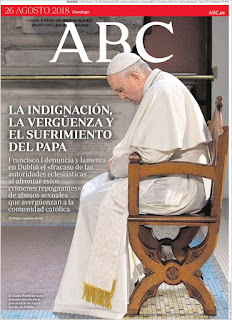 |
| From en.kiosko.net |
Pope Francis was in Ireland, met with its Prime Minister and eight survivors of child abuse by Irish priests, and attended
the 9th Meeting of Families in Dublin.
This came in the wake of the Pennsylvania report about the abuse of some thousand children by Catholic priests for several decades.
I picked a free copy of The New York Times International Edition while boarding the Cathay Pacific flight Saturday evening from Hong Kong to San Francisco. The front page story said: "As pope visits, rage at abuse. Faithful in rural Ireland call on Catholic Church to offer more than apologies"
As soon as I got settled in SFO early Sunday morning, I went through my world watch of newspapers at the en.kiosko.net website, and found these interesting front page treatments of the Irish journey of Pope Francis I:
 |
| From en.kiosko.net |
Sud Ouest (France): "The Church faces its demons. The very Catholic Ireland has been marked by the revelation of pedophile scandals and other abuses within the church. Beyond contrition, society expects actions."
El Pais (Spain), Sunday issue: "The new Ireland receives Pope with reproaches. Irish Prime Minister asks the Pope to go "to action" on the subject of abuse. The pontiff has met with eight victims of abuse during his trip"
ABC (Spain): "The indignation, the shame and the suffering of the Pope. Francis I denounces and laments in Dublin the 'failure of the ecclesiastical authorities to face these repugnant crimes' of sexual abuse that embarrasses the Catholic community"
The Irish Times (Sunday issue) reported that, according to two eyewitnesses, "Pope Francis referred to those who cover up child abuse in the Catholic Church as “caca” – the Spanish word for s**t – during a meeting in Dublin with abuse survivors."
 |
| From en.kiosko.net |
The Independent (UK): "Abuse shames church, Pope tells Ireland", and The Sunday Telegraph (UK): "Pope apologizes for Church child abuse"







